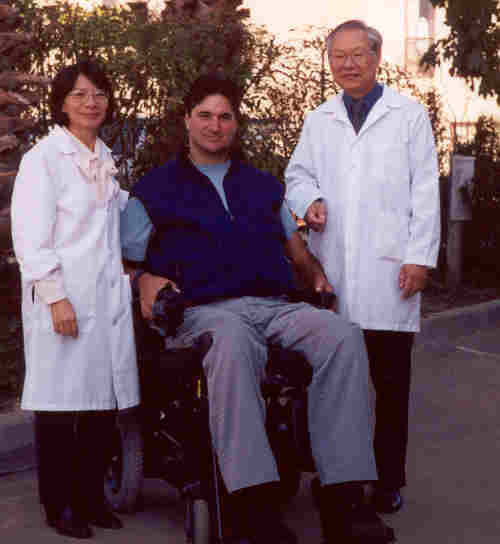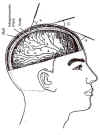
Scalp acupuncture is a specialized form of
acupuncture that has helped many people with nervous-system disorders,
including spinal cord injury (SCI) and multiple sclerosis (MS).
The leading force behind the therapy’s emergence
has been Professor Ming Qing Zhu. A 1964 Shanghai University of
Traditional Chinese Medicine graduate, Zhu has become an internationally
recognized and acclaimed acupuncturist, who has authored man y
publications, including a scalp acupuncture textbook, and lectured
throughout the world. Assisted by his associate Moyee Siu, Zhu currently
operates clinics in San Jose and Santa Cruz.
y
publications, including a scalp acupuncture textbook, and lectured
throughout the world. Assisted by his associate Moyee Siu, Zhu currently
operates clinics in San Jose and Santa Cruz.
Overview:
Supplementing
traditional body acupuncture, specific
areas, such as the ear, foot, hand, and scalp, represent acupunctural
microsystems for the entire body. Through treating a localized
microsystem, health-enhancing energy flow (also called qi) can be
stimulated in virtually any body part.
Although the
scalp acupuncture microsystem can treat most of the same disorders as
traditional acupuncture, it is especially effective in treating
nervous-system disorders and pain. For example, studies have shown that
scalp acupuncture has helped thousands of Chinese stroke patients,
apparently through altering blood hormone levels that influence
stroke-inducing platelet clumping. In addition, numerous people with MS,
SCI, amyotrophic lateral sclerosis (ALS), and head injury have also
benefited from scalp acupuncture. Zhu believes the therapy is most
effective when initiated soon after the traumatic injury or neurological
crisis.
Multiple Sclerosis:
According to
Zhu, scalp acupuncture will almost invariably reduce MS symptom
severity. Because so many people with the disorder have been treated, a
specific MS protocol has been developed and disseminated for use by
other acupuncturists (see www.scalpacupuncture.org).
While visiting Zhu’s clinic, I talked to Morgause, a woman with MS who
believes that her ambulatory and standing ability and energy levels have
increased significantly after only a few treatments.
Spinal Cord Injury:
Over his career,
Zhu has also treated about 20 individuals with SCI. Although he
emphasizes that scalp acupuncture is not a cure-all panacea, he says
most of his SCI patients have accrued significant
quality-of-life-enhancing health benefits, even though treatment was
usually initiated long after time of acute injury, the most optimal
therapeutic window. Even with chronic injuries, dramatic improvements
occasionally occur. For
example, one patient with a T-11 gunshot injury came in for pain
treatment and ended up regaining considerable walking ability.
Treatment Procedure:
Very fine
needles are painlessly inserted at a 15–30 degree angle into the thin
layer of scalp tissue (see illustration) in treatment zones associated
with specific body functions and regions
 To
stimulate qi flow, the needles are periodically manipulated.
To
stimulate qi flow, the needles are periodically manipulated.
Because the
needles are inserted in the scalp, the patient can receive treatment in
any position, and the needles can be left in for extended,
treatment-enhancing time periods without interfering with daily
activities. Typically, the needles remain inserted for at least the
two-hour clinic visit and often up to 72 hours.
Since much of
the treatment is carried out in Zhu’s reception room, patients with
diverse disorders often share their experiences and develop a
supportive, nurturing camaraderie and sense of connection.
From personal
experience, the scalp acupuncture is, indeed, innocuous. I felt no pain
when the needles were inserted and over time forget that they were there
until I would absentmindedly run my hand through my hair. The needles
didn’t interfere with my sleep that night and were only pulled out the
following morning because my vanity required that I do something with my
disheveled hair.
Physical Movement:
While the
needles are inserted, Zhu encourages patients to move the affected body
parts or, at minimum, visualize the movement accompanied with qigong-based
breathing practices that help direct the qi flow to the intended area.
He believes that such treatment-associated movement is critical in
improving connections between the central and peripheral nervous system.
Even in
paralysis cases, Zhu encourages these movements, using, as necessary,
assistive devices or the help of others. For example, I saw Morgause
with needles inserted in her scalp and using a walker trudging
purposefully across the 25-foot clinic floor. This was a major
ambulatory accomplishment for her.
Zhu related
another example involving an acutely injured young woman who had
acquired a clinically classified complete, C6-7 injury due to a car
accident. From her Vancouver hospital bed, she was assisted to a
standing position while being treated with scalp acupuncture.
Zhu believed this early treatment initiation, including the
woman’s efforts to stand, was largely responsible for her ensuing,
stunning functional recovery.
Alessandro’s Story:
At Zhu’s
clinic, I also talked to Alessandro,
an articulate, energetic 40-year old quadriplegic with a charismatic
smile and infectious enthusiasm. Before his injury, he led an active
lifestyle that reflected his love of the outdoors.
In 1997,
Alessandro‘s life changed in an instant due to a renegade wave he
chose to body surf.
“A small
two-foot wave became an eight-foot face that took my 6’2, 215 pound
body over the falls and dropped me headlong into the sand below…I
immediately heard a crack …and knew under no uncertain terms that I
was paralyzed.”
With his fifth
cervical vertebrae now crushed, Alessandro notes, “What was once an
active, adventurous outdoor lifestyle became an active, internal pursuit
of recovery.”
Alessandro
believes that Zhu’s care, treatment, and support was foremost in this
pursuit, and feels Zhu is his “primary doctor.”
Alessandro says
he fortunate to have been treated by Zhu initially only 12-days post
injury.
“My initial
treatment with Zhu in the hospital was not only incredibly and literally
electrifying, but it really made me feel more at ease with my situation,
physically, psychologically, and emotionally,” he says. “Moreover,
Zhu’s therapy significantly aided in getting me off the pain pills I
was taking as well as other drugs.”
In spite of an
original prognosis limiting his future activity to a “sip and puff”
wheelchair, Alessandro has regained considerable function, which he
attributes to Zhu’s treatment combined with his rigorous
physical-therapy regimen. Alessandro has regained arm strength, some
wrist control, and hand sensation, enabling him to use a phone handset
and feed himself without a splint. Because he has also regained
abdominal, lower back, and paraspinal muscles, he is almost at the point
of doing unassisted weight shifts and lifting his torso upright in his
standing frame. This additional torso strength has enabled him to sit
for a long time while exercising on his mat table. For example, he can
swing his arms back and forth in an exaggerated walking motion without
assistance or falling over.
Moreover,
Alessandro says that Zhu’s treatment has greatly enhanced his overall
wellness, allowing him to direct his energy to functional recovery
rather just attempting to stay well.
Conclusion:
Scalp acupuncture represents yet another
alternative healing modality, whose underlying philosophy and successful
clinical track record does not negate, but rather supplements,
conventional medicine’s many important contributions. If we can set
aside our progress-inhibiting illusions of knowledge and attempt to
open-mindedly integrate divergent health-care perspectives, such as
scalp acupuncture, we will have an expanded healing spectrum that can
only benefit individuals with disabilities.
For more
information, check www.scalpacupuncture.org
or call 408-885-1288.
Adapted from article appearing in Paraplegia News,
February, 2002 (For subscriptions, contact www.pn-magazine.com)